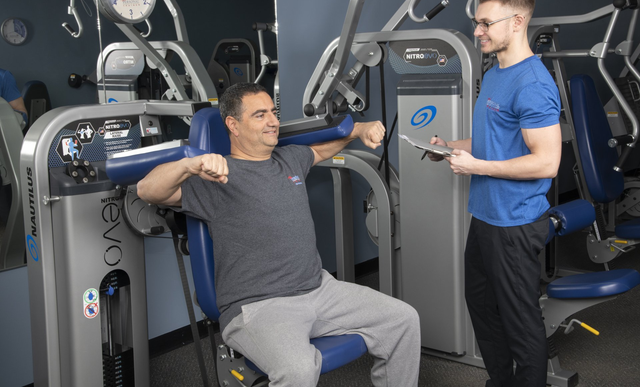
Strength Training in Your 50s and 60s
During their 50s, people can begin to experience a more sluggish metabolism, as it slows by 25%.
This can create a domino effect of other health issues, from lack of energy to weight gain and muscle loss. Many people in their 50s also start to develop the first signs of heart disease, as the heart walls thicken and valves stiffen. But heart disease is largely preventable. The heart is a muscle and can be kept strong through high-intensity strength training.
Maintaining normal weight and strength training in your 50s can pave the way for a brighter future of long and healthy aging.
Bone strength, muscle mass, flexibility, and balance are key considerations for people in their 60s.
Strength training done in slow reps helps avoid force on the joints, tendons, and connective tissue. Our fitness professionals are specially trained to work with people who may be rehabbing injuries, joint replacement, or chronic conditions, such as loss of bone density. According to the AARP, one in five women will suffer from osteoporosis by age 65. Also, during this decade, immune systems can weaken, leading to more vulnerability to diseases. And brain function for short- and long-term memory begins to slow.
Studies have shown you can combat age-related issues by maintaining an optimal weight and following a progressive strength training program.
Strength Training in Your 50s and 60s
During their 50s, people can begin to experience a more sluggish metabolism, as it slows by 25%.
This can create a domino effect of other health issues, from lack of energy to weight gain and muscle loss. Many people in their 50s also start to develop the first signs of heart disease, as the heart walls thicken and valves stiffen. But heart disease is largely preventable. The heart is a muscle and can be kept strong through high-intensity strength training.
Maintaining normal weight and strength training in your 50s can pave the way for a brighter future of long and healthy aging.
Bone strength, muscle mass, flexibility, and balance are key considerations for people in their 60s.
Strength training done in slow reps helps avoid force on the joints, tendons, and connective tissue. Our fitness professionals are specially trained to work with people who may be rehabbing injuries, joint replacement, or chronic conditions, such as loss of bone density. According to the AARP, one in five women will suffer from osteoporosis by age 65. Also, during this decade, immune systems can weaken, leading to more vulnerability to diseases. And brain function for short- and long-term memory begins to slow.
Studies have shown you can combat age-related issues by maintaining an optimal weight and following a progressive strength training program.
Key Benefits of Strength Training
✔ Decreases body fat
✔ Build strength with muscle
✔ Increases resting basal metabolic rate
✔ Lowers bad cholesterol
✔ Improves cardiovascular system
✔ Resistance to aging
✔ Protects against injury
✔ Boosts the immune system
✔ Reshapes the body
✔ Improves flexibility, balance, and range of motion
✔ Increases bone density, decreases the risk of Osteoporosis
✔ Decreases body fat
✔ Build strength with muscle
✔ Increases resting basal metabolic rate
✔ Lowers bad cholesterol
✔ Improves cardiovascular system
✔ Resistance to aging
✔ Protects against injury
✔ Boosts the immune system
✔ Reshapes the body
✔ Improves flexibility, balance, and range of motion
✔ Increases bone density, decreases the risk of Osteoporosis






